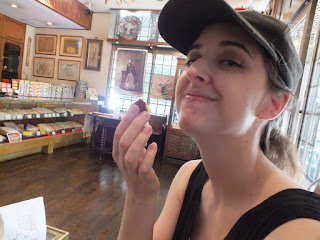A while back, Nana and I spent a fascinating weekend in Nagasaki (previous posts here, here, and here). For a long time, Nagasaki was Japan's gateway to the West. In fact, for centuries it was Japan's only source of sugar, shipped in from Portugese and later Dutch trading posts in Southeast Asia. Even today, Nagasaki is home to several popular Japanese treats that harken back to the city's cosmopolitan past.
The best known of these is probably castella, a mild sponge cake based on an old Portugese recipe named after the Spanish kingdom of Castille.
 |
| Classic variety in the foreground, green tea variety in the back. |
 |
| Nana is a fan. |
This one was even milder in flavor and more focused on texture: once bitten, the thing would crumble into a fine powder in your mouth, then dissolve into a thin mochi-like goo. Odd, but not unpleasant.
Back in the day, both of these treats, along with any sweets not based on red bean, were extremely expensive, given the scarcity of sugar, and entirely dependent on the Dejima trade. These days, imported sugar is abundant, and while the Japanese palate tends towards less-sweet sweets as a whole, those sweets have become affordable snacks.
Today's Lesson
カステラは 好き です。
kasutera-wa suki desu.
Castella-(subject) pleasing is.
I like Castella.
Bonus Lesson: To sound more Japanese, you barely pronounce the "u" in "su," so that "suki desu" sounds more like "ski dess."
Bonus Bonus Lesson: Note how "castella," like most loan words, is written in katakana ( カタカナ ), the more "angular" of the two Japanese phonetic scripts - not hiragana ( ひらがな ), the more flowing script used for native Japanese words.


No comments:
Post a Comment